MSI GE40 Review: a Slim Gaming Notebook
by Jarred Walton on July 16, 2013 3:00 AM ESTMSI GE40 Gaming Performance
Our notebook gaming suite is now set for 2013, and I'm toying with the addition of Company of Heroes 2 as a second RTS/strategy data point. We’re still collecting performance results for CoH2, however, so for now I’ll refer you to Mobile Bench for those numbers. Let's just say that the game can bring even powerful notebooks to their knees.
We’ve also got the GTX 680M courtesy of the Alienware M17x R4 in the gaming charts, along with the other notebooks from the previous page. Here are the charts, and please take the time to read the commentary before trying to draw too many conclusions as there’s more going on than may at first be apparent. We’ll start with the Value charts, where the CPU becomes even more of a factor, and then move on to the Mainstream charts.
Notebook “Value” Gaming Performance
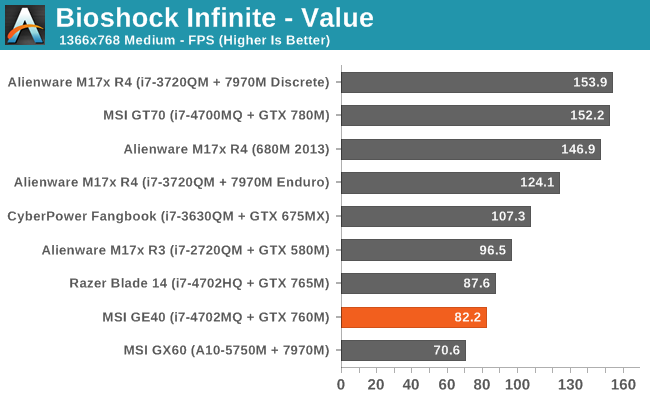
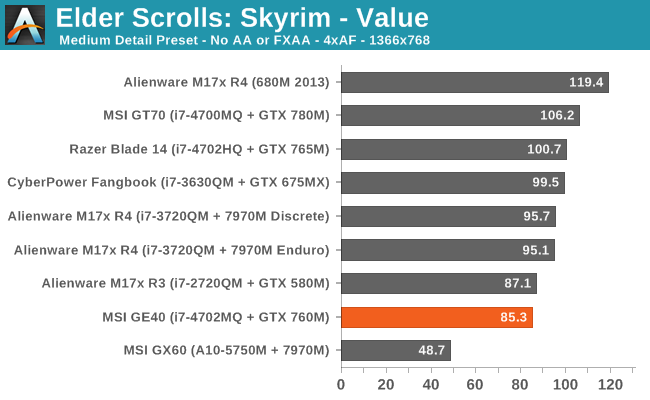
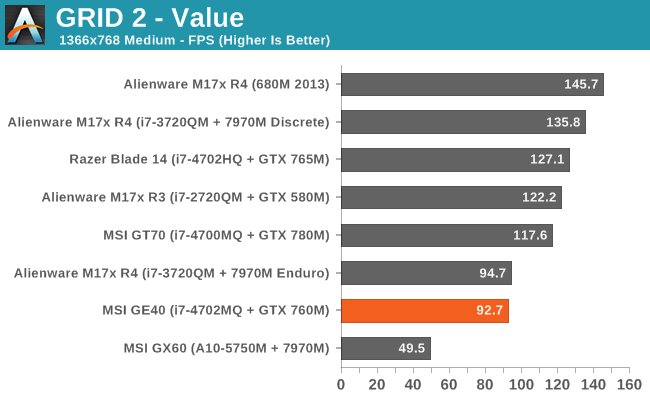
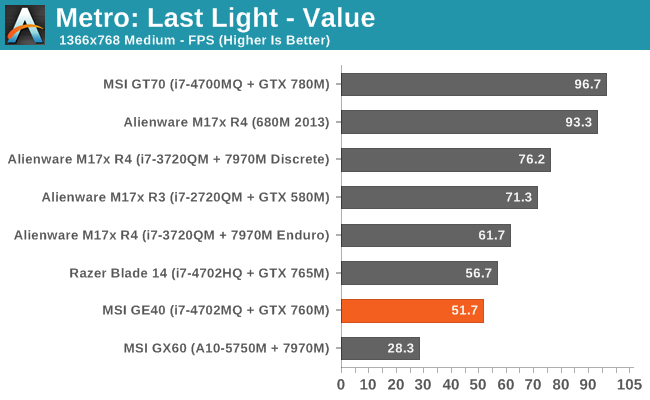
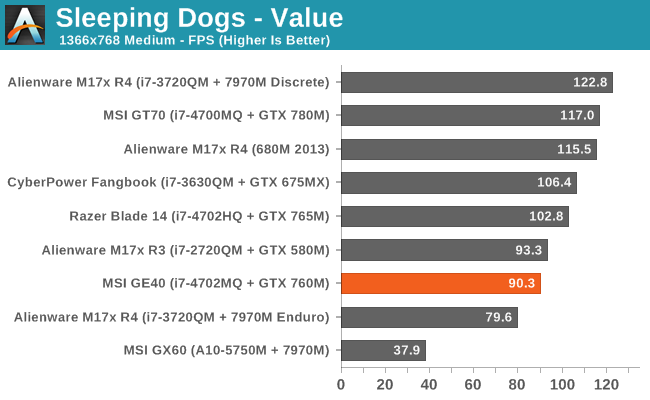
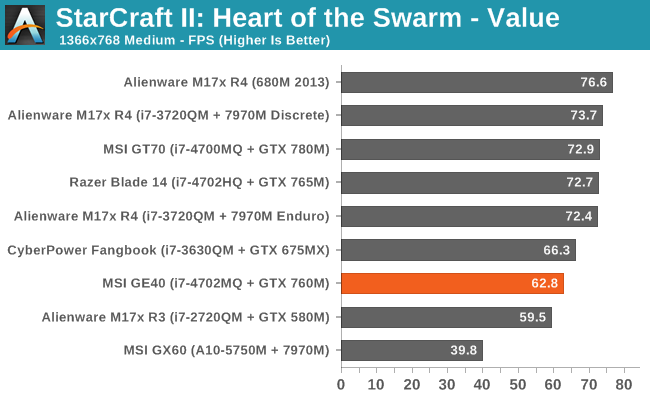
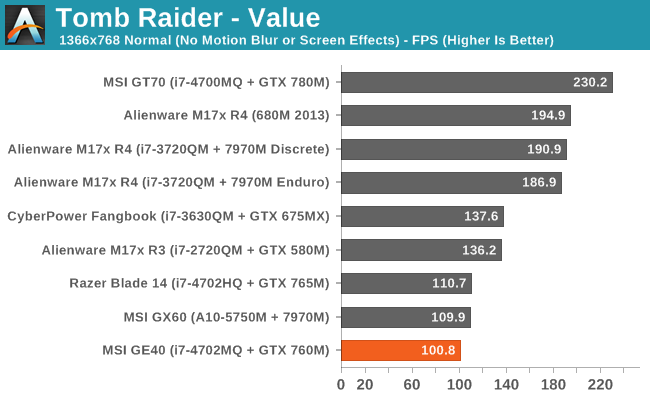
Notebook “Mainstream” Gaming Performance
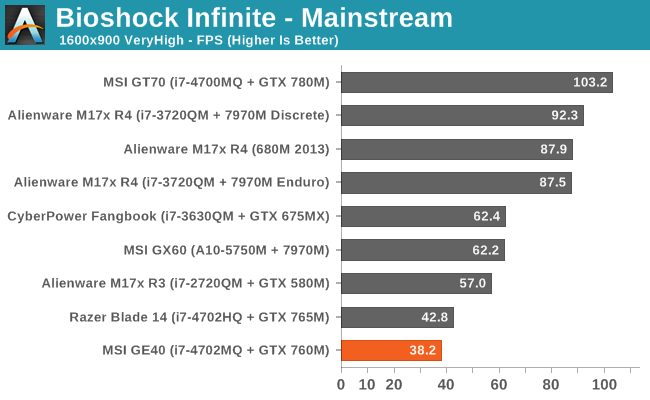

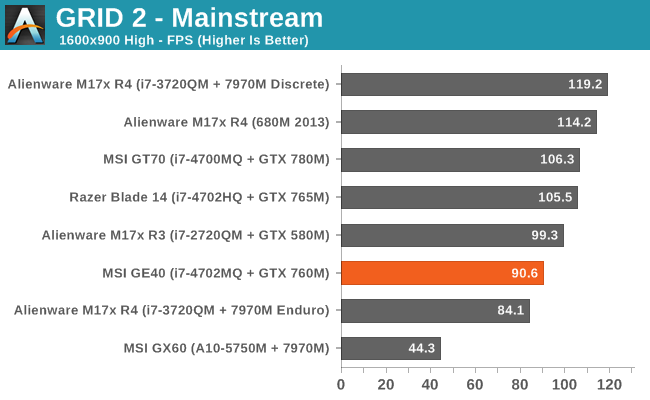
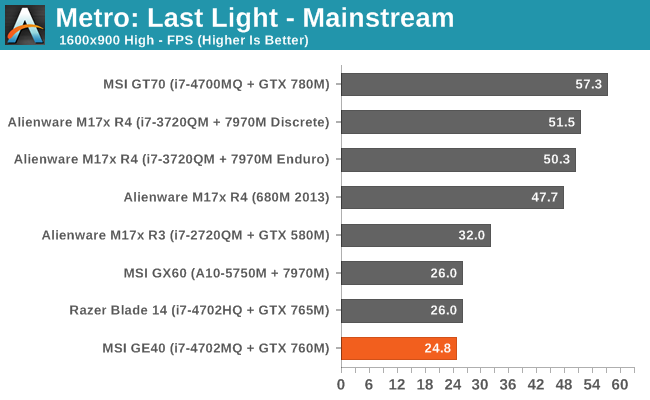
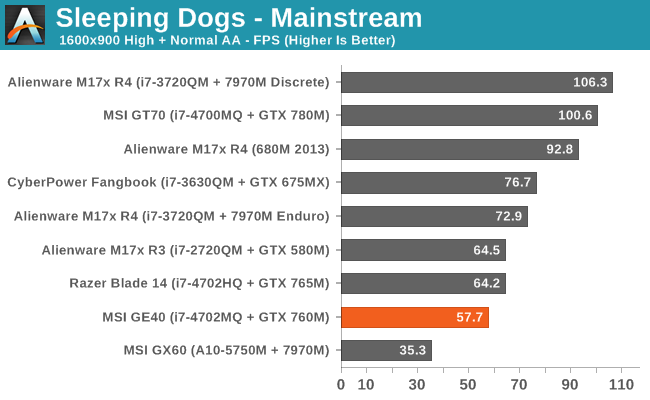
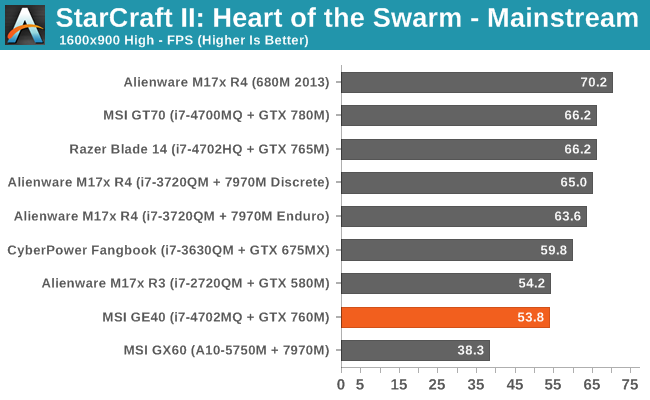
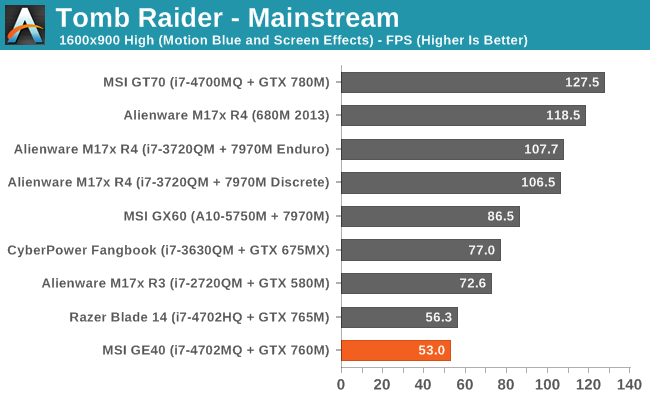
First, let me get this out of the way: the GTX 780M performance looks rather poor in many of these gaming benchmarks. The reason isn’t that our benchmarks are inherently flawed or even that the MSI GT70 is a “lemon”; rather, we’re looking at lower quality settings where the CPU plays a much greater role. We have another laptop (Clevo P157SM) with i7-4700MQ and GTX 780M, and while it’s sometimes up to 7% faster than the GT70, there are also instances where the GT70 wins by 5%; on average, our P157SM numbers average out to 0.01% faster at our Value settings and 1.3% faster at our Mainstream and Enthusiast settings.
The long and short of it is that the GTX 780M needs more CPU to really stretch its legs in some games; we’ll have a full review and investigation of CPU scaling with the GTX 780M in the future, but no matter how crazy it might seem, the results from our GT70 review aren’t far off of what you can expect in the games we’ve benchmarked at the settings we’ve used. Certain titles in particular are very CPU limited (Skyrim and StarCraft II), even at higher quality settings, and the i7-3820QM ends up being faster than the i7-4700MQ by a decent margin. (Note that the i7-4700MQ is really the replacement for the i7-3610QM, so the 3820QM is two steps above the 4700MQ.)
We can get a better idea of where the CPU matters most and where it matters least by looking at the performance of the MSI GX60. The HD 7970M is definitely faster than the GTX 760M and GTX 765M in most disciplines (e.g. look at the M17x 7970M discrete results; on average it’s 29%/41% faster than the 765M at Value/Mainstream and 50%/61% faster than the 760M), so when it loses—especially by a large margin—to the GE40, we’re looking at CPU bottlenecks. The only Value benchmark where the GX60 beats the GE40 is Tomb Raider; elsewhere it’s anywhere from 14% (Bioshock) to 58% (Sleeping Dogs) slower, and on average the GE40 runs through our Value suite 47% faster than the GX60! At the more demanding Mainstream settings, the gap narrows and the GX60 now claims wins in Bioshock, Metro: Last Light, and Tomb Raider; the GE40 is still 15% faster on average, with large wins in Skyrim, GRID 2, and Tomb Raider. It’s only at our Enthusiast settings that the GX60 starts to win in a majority of the games we’re testing. (Those scores aren’t shown here but they’re available in Bench—we figure with a 1600x900 panel and moderate GPU we didn’t need to show maxed out 1080p performance, but it’s still interesting to see how the GTX 760M handles those settings.)
Other than the GTX 780M “oddities”, the MSI GE40 places about where we’d expect. It’s always behind the Razer Blade 14, though again there appear to be cases where the Blade is hitting higher CPU turbo speeds. On paper the GTX 765M should at best provide 30% more performance than the GTX 760M (thanks to the higher core clocks). The average lead of the Razer Blade is 16% at our Value settings and 14% at our Mainstream settings, but the GRID 2 Value result is 37% faster on the Blade. Considering the increase in cost, though, that’s probably a performance tradeoff many would be willing to make.
Overall, the GE40 gets more than 60FPS in nearly every title we tested at 1366x768 Medium settings, and more than 30FPS at 1600x900 High settings. The one exception from our graphs: Metro: Last Light, where you can expect reasonable frame rates at 1600x900 Value settings but our Mainstream settings prove to be too much. Company of Heroes 2 is another brutal game, with Medium/Low 1366x768 settings getting a paltry 29FPS on the GE40 while the High/Medium 1600x900 results drop down to 23FPS. Hopefully a patch or new drivers will improve CoH2 performance—sooner rather than later—because right now the built-in benchmark can make even a GTX 780M struggle (e.g. 55FPS at our Value settings, 51FPS at Mainstream, and 23FPS at Enthusiast).










93 Comments
View All Comments
JarredWalton - Tuesday, July 16, 2013 - link
I would have reported throttling had it been evident. The CPU speed is dropping down from max turbo, but it's staying in the rated 2.2-3.2GHz throughout all the testing that I logged. In fact, for Metro Last Light, out of 500 data points over 1000 seconds, there was only one instance of 2.3GHz; everywhere else the CPU close were at least 2.4GHz and the average was 2.8GHz. I won't go so far as to say that the GE40 will never throttle while gaming, but it's definitely doing better than the Dell XPS 15 or Samsung Series 7 managed to do under similar testing.kogunniyi - Tuesday, July 16, 2013 - link
Will Anandtech review the Alienware 14 (and 17)?ufranco - Tuesday, July 16, 2013 - link
Just a side note , sorry to be off topic, wondering if you would be kind enough to do a review of windows 8.1 on a high dpi monitor to check how windows reacts.adityarjun - Tuesday, July 16, 2013 - link
I too would like to read about this. A para is written here http://www.anandtech.com/show/7145/asus-pq321q-fir... I am sure more will be said in the final review.adityarjun - Tuesday, July 16, 2013 - link
Just in case you do review the Alienware 17, please do note that it does throttle above 77C. The same goes for my current m17xr3. Despite reading almost every review on the net, i found out about this only after buying it. None of the reviews mentioned this.And this is not a throttle that can be ignored by someone like me from India where the ambient temperatures are quite high. I regularly hit 77C and it is a huge pain.
So in your reviews please mention this.
Also it would be great if in your gaming laptop reviews you would mention the gpu temperatures for different ambient temperatures (like doing the tests with AC on and then off).
And, as always, keep up the excellent reviews :)
kogunniyi - Tuesday, July 16, 2013 - link
You can fix the throttling by flashing a vBIOS or changing the temperature limit in Nvidia Inspector. Besides, the 780m should not reach 77C in the 17 after a good application of thermal paste.adityarjun - Tuesday, July 16, 2013 - link
No you cant.. Flashing vbios allows over volting. The 77C throttle remains.A repaste is not enough. My room temps are in the 35C range.
noeldillabough - Tuesday, July 16, 2013 - link
Eek, I cry when the room goes over 23Cadityarjun - Tuesday, July 16, 2013 - link
Haha.. Visit India during summers :)DanNeely - Tuesday, July 16, 2013 - link
Not going to happen unless I was only in the lowlands for long enough to board a second plane or a train heading for the mountains. Enough elevation can fix sub-tropical heat. :D